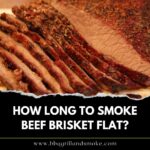In this guide, we will be looking into the beef grading system, particularly understanding prime vs choice vs select.
In the beef grading system, prime beef is the highest quality of beef, followed by choice beef, which is the second highest, and select beef, which is the last.

It is quite important that you know the difference between the USDA beef grades, Prime, Choice, and Select, when it comes to purchasing beef.
You will save yourself money by being aware of the differences between these meat grades, as there is a massive quality, price, and taste difference between them.
Is All Beef Graded?
The short and straight answer to the above question is no; not all beef is graded.
However, all beef in the United States is inspected. Beef grading is actually voluntary, administered by the USDA, and also paid for by the beef packers.
How Is Beef Graded?
The meat’s intramuscular fat marbling and the maturity of the cattle at the time of slaughter are what determine how the beef quality grades are assigned.
These USDA meat grades help when it comes to identifying the juiciness and softness of the meat when cooked.
The USDA can also assign a yield grade to beef, and this has to do with the amount of lean meat on a carcass.
This number grade is used during the harvesting and distribution process to market cattle.
What Are the Grades of Beef?
The USDA grades beef to show that it is premium-quality beef that is safe for consumption.
In addition, the beef grades help show you the amount of tenderness and marbling to expect in the beef.
There are actually eight grades of beef. The beef quality grades are in the range of best to worst, and they include USDA Prime, USDA Choice, USDA Select, USDA Standard, USDA Commercial, USDA Utility, USDA Cutter, and USDA Canner.
Normally, you only hear about three of these USDA beef grades when you are purchasing beef at a steakhouse, and they include Prime, Choice, and Select.
Prime Beef
Prime beef is obtained from young, well-fed beef cattle.
It contains massive marbling, which is the amount of fat dispersed in lean meat.
In general, it is sold in restaurants and hotels. When it comes to dry-heat cooking like grilling, roasting, or broiling, prime roasts and steaks are your best options.
Choice Beef
Choice beef is premium quality; however, compared to Prime, it has less marbling.
Choice roasts and steaks from the loin and rib are also suited for dry-heat cooking, and they are also extremely juicy, tasty, and tender.
A lot of the less tender cuts can also be cooked with dry heat, but if not overcooked.
If roasted, simmered, or braised, such cuts will be most tender with just a small amount of liquid in a tightly sealed pan.
Select Beef
In terms of quality, Select beef is extremely uniform and usually leaner in comparison with the higher grades.
It is rather tender, but it might lack some of the juiciness and flavor of the higher grades due to the fact that it has less marbling.
Keep in mind that only the tender cuts should be cooked with dry heat.
In the case of other cuts, they should be marinated before cooking or braised in order to gain maximum flavor and tenderness.
Furthermore, Standard and Commercial grades of beef are mostly sold as ungraded or as store-brand meat.
Whereas Utility, Cutter, and Canner grades of beef are rarely, if ever, sold at retail, however, they are used rather than to make ground beef and processed products.
Prime vs Choice Beef
The fact that prime grade beef has a massive fat marbling of 8–13% fat, whereas choice beef features only 4–10% fat, is the difference between prime and choice beef.
This actually makes prime-grade beef more succulent, tasty, and juicer in comparison with choice-grade beef when cooked.
Normally, prime beef is kept for grand dining settings, whereas choice-grade beef is usually served in casual dining restaurants.
Choice vs Select Beef
In the case of choice and select beef, the difference between them is the fact that choice-grade beef features 4–10% fat, whereas select-grade beef has 2–4% fat.
In turn, this makes choice grade beef tenderer and juicer compared to select.
Most times, choice beef will be used in chain restaurants, and select beef is sold for residential and retail use.
Prime vs Choice vs Select
In comparison with the three top grades of beef, you will find that prime beef features massive marbling and has the highest price tag; it is mostly a prized purchase at a steakhouse.
In the case of choice beef, it comes with decent marbling, which makes it a more attainable but still top-quality choice for restaurant goers.
Now, select beef features extremely little marbling, which makes it the leanest of the top three beef grades.
However, it is quite inexpensive but might need special care during the preparation process, as this will help make sure that the final result is tender and not dried out.
What to Look for When Choosing Beef
When it comes to choosing cuts of beef, there are a few things you need to look for, and this goes the same regardless of the grade or cut.
I strongly suggest that you always go for beef with a vibrant red color and that is firm to the touch.
Stay away from packages where the beef looks wet, comes in a grayish color, or has excessive liquid.
The packaging has to be cold and should also be without tears or holes.
You are free to ask a butcher to see the piece up close when you are buying from them; this is to see if it is firm to the touch and smells fresh.
Keep in mind that older beef comes with a distinguishable unpleasant smell, and when possible, stay away from it.
Try to buy beef before the sell-by date and ensure that it is also close to the time it will be cooked.
In the case of flavor, freshness is what makes a difference. Dry-aged beef is a completely different thing with its own standards.
Frequently Asked Questions
Below are a few of the most frequently asked questions that have to do with this topic:
Is USDA Select Bad?
The straight answer is no; USDA Select is not bad. It is actually still perfectly good beef, given that it is still one of the top grades.
Although it is still not as good as prime or choice, it is also far from being low-grade.
Is Costco Prime Beef Really Prime?
Yes, Costco Prime beef is really prime. It is actually USDA prime meat.
You will find it in smaller quantities compared to what you are used to; however, it is still above par.
What Meat Grades Do Not Mean?
There is no doubt that the USDA does an excellent job when it comes to grading beef, and they are always improving and advancing.
That being said, it is quite important to note that some factors that a lot of consumers now consider vital do not go into the grade.
These factors include the cut, how the animal has been raised (pasture-raised or not), and the animal’s diet (grass-fed vs. grain-finished).
Final Thoughts
This is very important for you to know about the different grades.
It will be so much easier to make the right choice for your next dish with this information in hand.
That being said, and in addition, you are also free of the worry of being misled into selecting unnecessarily costly cuts of beef.
It is a fact that sometimes a cheaper option can work just as well.
This concludes this guide, as you now have everything you need on the beef grading system and also understanding prime vs choice vs select.





